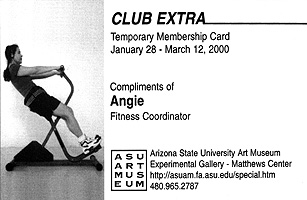
Club Extra
“Beauty” is spandex on a perfectly toned thigh, perspiration on an upper lip, sweaty underarms of live artists in action. A fitness club, a performance venue, and an art museum are all spaces of objects and subjects of beauty. All share the promise that their institution might help us transcend the physical to the ethereal. We sweat, we critique, we long to be a part of these institutions of absolute beauty.
Club Extra is inspired by the similarities between health fitness clubs and art museums. We become members, bring friends, grapple with beauty, carry attitude, and gaze at what we want (or wish we had) while trying to achieve profound aesthetic connections. The vaporous sweat of art enthusiasts and health fanatics will fill the space of a major art institution.
Club Extra Operates on Three Different Levels
Special one-hour exercise classes will be held in the Experimental Gallery of the Arizona State University Art Museum throughout the exhibition. Participants are invited to work off “Art Ass” or observe others work it off for them. The classes will be complete with an instructor, loud music, All-Sport power drinks and a towel girl/boy. “Angie,” the Fitness Coordinator of Club Extra, will facilitate all classes and club activities. Angie doesn’t have a degree in cardiovascular performance, but she knows how to “turn it on” and she wants others to reach that higher state of performance.
While riding a stationary bicycle or developing inner thigh muscles, participants can listen to “Walkin’ to Concepts” and “Sweatin’ for Academia.” Participants not interested in “collaborative” performance can visit the interactive installation and check out a headset of “Theory-on-Tape.”
Using the strategy of local fitness clubs, there will be brochures and free membership opportunities at major sites around the Tempe/Phoenix area. Temporary membership cards will be distributed in the exhibition invitation.
Complimentary
Temporary Membership Card:

About the Artist
Angela Ellsworth currently resides in Phoenix, Arizona, where she is a visual and performance artist. She received her Master of Fine Arts in Painting and Performance from Rutgers State University of New Jersey in 1993.
Her recent projects include: performance/installation at the Salt Lake Art Center for Out of the Closet which also included three of Ellsworth’s mixed media works; performance/installation at Barlow & Straker in Phoenix with Tina Takemoto as Her/She Senses entitled Squeak and Clean</em>; and waist/waste room, a performance for the opening reception of the Arizona State University Art Museum exhibition Art on the Edge of Fashion.
Ellsworth’s writing will be published in the upcoming performance book, Women’s Comedy: Cross-Cultural Perspectives on Gender and Humour, edited by Lizbeth Goodman (Cambridge: Polity Press) and an issue of Contemporary Theatre Review on performance and disability with a paper entitled Performing Illness: Crisis, Collaboration and Resistance.
ASU Art Museum Presentation
Organized by John D. Spiak, Club Extra will be installed in the 2,400-square-foot Experimental Gallery of the Arizona State University Art Museum at Matthews Center.
Duration
Club Extra (January 29 – March 12, 2000) is open from 10 am to 5 pm, Tuesday through Saturday. Special one-hour exercise classes will be offered during the run of the exhibition. Club Extra will be open from 1pm – 5pm on Sunday, March 12, to accommodate attendees of the Performance Studies International Conference that will take place March 9 through March 12 on the ASU campus.
Support
The exhibition at the Arizona State University Art Museum is supported in part by L.A.P. (Live Art Platform) and Friends of the Arizona State University Art Museum. Support for the opening reception generously provided by Trader Joe’s, Surf City Squeeze and Pepsi.
Please Note: Individuals workout and use equipment at their own risk.
Performances by Angela Ellsworth at ASU Art Museum
Actual Odor at Token City reception
waist/waste room at Art on the Edge of Fashion reception
For more information contact John Spiak at spiak@asu.edu or 480.965.2787.
Image credit:
